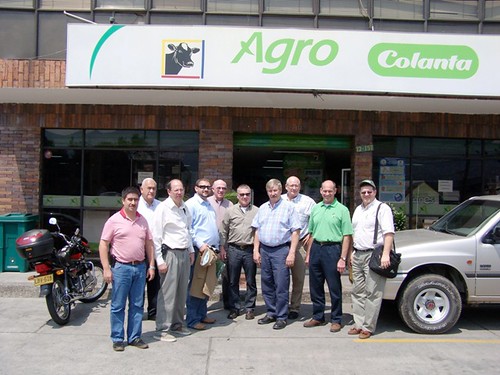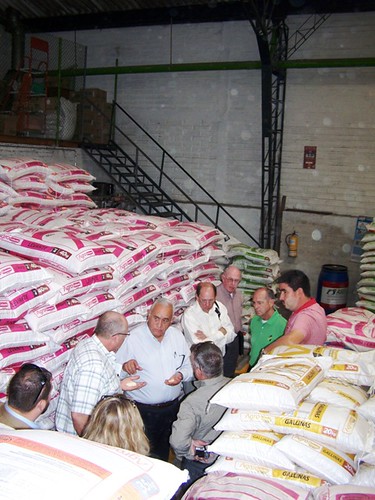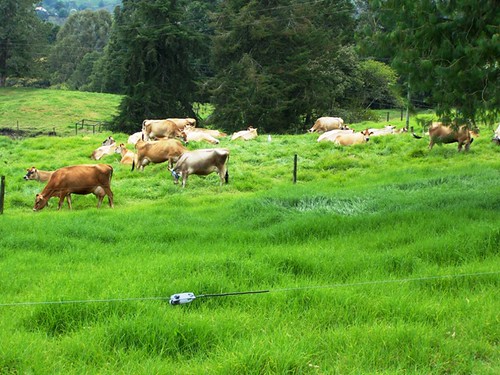By Curt Friesen, District 3 Director & Secretary/Treasurer on Nebraska Corn Board
 Corn growers from Iowa, Illinois and Nebraska participated in a trade mission to Colombia, following the U.S. Grains Council conference in Panama. I wanted to share about my unique experience in Colombia after the Free Trade Agreement was recently passed.
Corn growers from Iowa, Illinois and Nebraska participated in a trade mission to Colombia, following the U.S. Grains Council conference in Panama. I wanted to share about my unique experience in Colombia after the Free Trade Agreement was recently passed.
The economy is weak in Colombia with minimum wages being around $400/month. A good job may pay around $800-900; however, fuel prices are very high being around $5-5.50/gal.
We have lost 80% of our corn market share in just the last couple of years. Our poor 2009 crop has been blended into the next two years of good crops. I was told by a producer in Illinois that there were barges setting in New Orleans for over 2 years waiting to be blended off with good corn.

We met with Alejandro Jaramillo, the logistics manager at Contegral S.A. which is a major feed supplier in Colombia.
- Import about 25,000 MT of corn a month. Furnish ingredients or complete feed for cattle, hogs broilers, laying hens and fish.
- Received very bad quality corn in 2009. Cargo not evenly blended, some would come off as very good #2 corn and some would come off as #3 corn. Cargo overall would average #2. Wouldn’t mind if cargo would come off evenly blended as #2 corn.
- Now import most of their corn and DDG from Colombia. Better quality at a cheaper price.
- Feed very little DDG, say price is too high.
- I don’t feel that they are very knowledgeable about DDG. Have not heard of feeding DDG to fish.
- Argentine corn is harder and field dried so has less damage.
- Argentine corn is higher in protein. Showed chart with US corn at around 7.2% protein and Argentine corn above 8%.
- DDG content to variable. Would like to see more consistency in quality and content. They should try and source from a single plant so they know what they are getting. Now barges are gathered at port and traded so many times that shipment from many different plants end up in one cargo.
- Do have RFS, E-10, standard so may import ethanol and bio-diesel.
Colombian Pork Producers
- Association has around 380 members which covers about 80% of the pork industry. Provide economic and research programs for producers.
- 9.8% growth with approximately 2.74 million head
- Pork consumption has been slowly increasing, industry hit hard with misinformation – swine flu, etc.
- Very unstable prices for pork with 3 year cycle.
- Grain Is imported to either Atlantic or Pacific ports.
- Transportation costs are extremely high with very poor infrastructure.
- Cost of production is 76% feed, labor 7%, and 6% for transportation.
- 46% of pork imports come from US. Tariff is based on Andean price band system that uses a look back 60 month average of prices
- Do not use DDG in feed. Price to high and quality to variable. DDG contain elevated levels of mycotoxin.
- Argentine corn better quality, higher protein, and cheaper even with higher freight costs.
- Checkoff on hogs is $3.50/head.
Poultry Industry
- Issues with corn quality. Need a reliable supplier with consistent quality.
- Want to buy corn IP from elevator.
- With the free trade agreement, the poultry and hog industry will be destroyed in Colombia.
- Need consistent quality DDG.
- 3.1% growth in chicken industry, $3.6 billion dollar industry
- We need to look into the logistics of getting IP grain either to the gulf or PNW.
Colanta Dairy Cooperative
- Vertically integrated farm coop. Members purchase all supplies from coop and sell all products to coop and then coop sends them the difference once a month.
- Import around 1200 mt/month of fertilizer; sell approximately 10,000 mt/month of feed.
- Have around 11,000 members.
- Lend money to members at around 14% interest.
- Export cheese to US
- Average dairy herd is about 30 cows
- Import most of corn from Argentina or Brazil
- Have stores around the country that sell milk, meat, vegetables and all other products produced by its members.
- Visited local dairy. He milked 34 cows in a very modern 3 station milking parlor that was computerized to track milk production from each cow.
They have fair amount of land to develop in the eastern part of the country if they can overcome the lack of infrastructure. Building roads in the steep terrain is very challenging, many areas receive over 240 inches of rain per year and roads are constantly washing out. Rumors have it that China may be investing in infrastructure in Colombia in order to obtain cheaper food supply.
View my pictures on our online Flickr photo album.
































